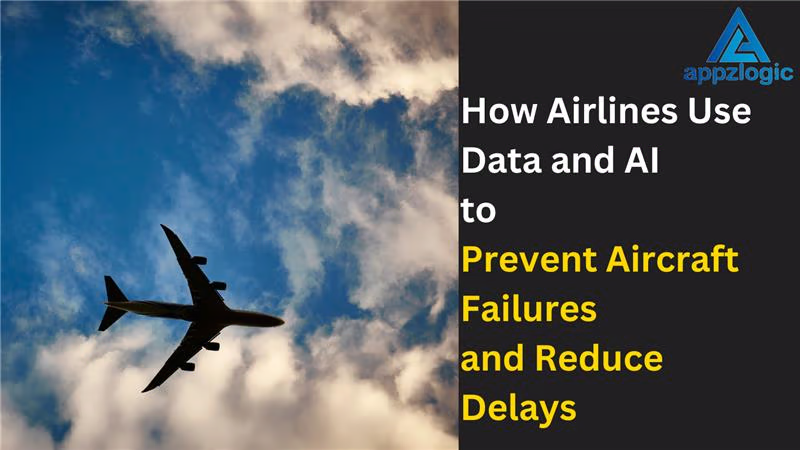
How Airlines Use Data and AI to Prevent Aircraft Failures and Reduce Delays
Technology plays a crucial role in enhancing aviation safety, it ensures efficiency and enabling smooth operations. Effective software systems help airlines avoid risks, reduce delays, and improve customer experiences and this helps in smooth functioning of an airline. The Aviation sector needs reliable software to ensure safety. Aircraft reliability is critical to achieving these goals. For the very first time in 2025, the aviation sector is all set to exceed $1 trillion in revenue, marking a strong recovery in aviation after the COVID-19 pandemic.
AI Driven Future of Aviation
The Aviation industry is seeing major technological changes due to the advancement of AI as it helps in various way in airlines industry solutions. Aviation deals with vast amounts of data and this data is crucial to maintain from traveler and customer management to crew management and the maintenance of the need of AI is clearly visible in this sector. The global artificial intelligence in aviation market size is estimated to reach USD 23 billion by 2031
Main Application of AI in Aviation
Crew Management: This ensures staff are well-rested and flights are properly manned. According to Symphony Solutions the Malaysia Airlines locked a five-year deal to transition its crew management system to IBS Software’s iFlight Crew.
Revenue Management: AI predicts passenger demand and adjusts ticket prices accordingly. It ensures airlines maximize profit by offering competitive fares based on trends and data.
Air Safety and Airplane Management: AI monitors aircraft systems in real-time to detect potential issues. It also assists in maintenance planning, improving overall flight safety.
Feedback Analysis: AI scans passenger reviews, complaints, and feedback to identify trends. Airlines can improve services based on customer insights.
Messaging Automation: AI chatbots handle customer inquiries about bookings, delays, or baggage, providing quick and accurate responses.
Fraud Detection: AI detects suspicious activities, such as fake bookings or payment fraud, by analyzing unusual patterns and behaviors.
Key Factors for Reliable Aviation
1. Regular Maintenance Checks
Routine maintenance helps airlines detect and fix issues early. Regular inspections, part replacements, and system tests prevent unexpected failures and improve performance. Airlines follow detailed maintenance schedules that ensure all aircraft components are functioning properly. Airlines also invest in specialized tools that automate inspection tasks, improving accuracy and speed. By incorporating automated inspection solutions, maintenance teams can detect hidden issues more effectively.
2. Predictive Analytics for Problem Detection
Modern airlines use autonomous technology and data tools to predict potential issues. By tracking sensor data, predictive analytics identifies warning signs before problems arise. Using data analytics and AI to predict when an aircraft component is likely to fail allows airlines to schedule proactive repairs, reducing unexpected breakdowns and improving fleet efficiency. Predictive analytics also minimizes delays by ensuring maintenance crews are prepared with the necessary parts and resources.
3. Skilled Maintenance Teams
Trained engineers and technicians ensure accurate repairs. Ongoing training programs help staff stay updated with new technologies and repair methods which reduces downtime. Airlines invest in virtual reality (VR) and augmented reality (AR) training tools to enhance learning experiences for maintenance staff. These technologies simulate real-world repair scenarios, giving engineers hands-on practice with complex systems. Training programs also focus on integrating IT solutions, ensuring maintenance teams can effectively use diagnostic tools and maintenance tracking software.
4. Efficient Spare Parts Management
Keeping essential spare parts in stock prevents delays. Digital inventory systems track parts and make replacements faster, reducing aircraft-on-ground (AOG) situations. Airlines use advanced inventory management systems to forecast demand for parts, ensuring critical components are always available. These systems automate ordering processes, minimize human errors, and enable better coordination between warehouses and maintenance teams. Airlines can also use blockchain technology to improve part traceability, ensuring all components meet regulatory standards and maintenance guidelines.
5. Digital Tools for Maintenance Tracking
Automation software helps track maintenance schedules, identify faults, and manage records. These tools reduce errors and streamline processes, improving fleet reliability. Airlines implement comprehensive maintenance management platforms that provide real-time data on aircraft health, maintenance history, and required repairs. These platforms enable maintenance teams to access detailed insights on every aircraft, ensuring issues are resolved quickly. Digital tools also allow airlines to schedule preventive maintenance based on usage data, reducing unexpected failures.
6. Clear Communication Systems
Fast communication between pilots, maintenance crews, and ground staff ensures technical issues are resolved quickly. Effective communication reduces delays and improves decision-making. Airlines use integrated communication platforms that connect all operational teams in real-time.Airlines can also integrate AI chatbots into these systems to provide instant guidance and troubleshooting tips for ground staff during urgent situations.
7. Strict Safety Audits and Regulations
Following safety standards and performing regular audits ensure safe operations. Compliance with guidelines helps airlines identify areas for improvement and maintain reliability. Digital audit platforms simplify compliance tracking by storing documentation, certifications, and maintenance records in one centralized system.
Testing Strategies for Reliable Aviation Software
1. Automated Testing for Faster Results
Automation tools run predefined scripts to test software functions. This approach speeds up testing, reduces manual effort, and improves accuracy. Focused impact-based testing ensures critical features are thoroughly checked during updates. Airlines integrate automated testing platforms that simulate real-world scenarios, including system overloads and sudden data spikes and ensure security testing.
2. Regression Testing for Stability
Even small software updates can cause system errors. Regression testing verifies that recent changes do not introduce new issues, keeping the system stable. Airlines rely on continuous integration tools that automatically run regression tests whenever developers make code changes.
3. SonarQube for Code Quality
SonarQube is a helpful tool that scans code for bugs, security risks, and coding errors. Developers can fix these issues before deployment to ensure software stability. Airlines use SonarQube to maintain coding standards across large development teams.
4. AccelQ for Easy Automation
AccelQ enables testers with minimal coding skills to contribute to automation testing. Its user-friendly interface allows testers to build automation scripts easily, ensuring broader team involvement. Airlines use AccelQ to automate repetitive testing tasks such as user interface (UI) validation, data entry checks, and performance testing.
5. ARD and CM Tools for Better Management
Agile Requirements Designer (ARD) and Configuration Management (CM) tools help manage complex software systems. These tools improve consistency, minimize errors, and support smooth software updates. Airlines use ARD to map out software requirements visually, reducing confusion during development.
Preventing Software Bugs in Aviation
1. Early Problem Identification
Proactive testing methods help detect issues during early development, allowing developers to fix problems before they affect users. Airlines use static code analysis tools to scan code as it is written, identifying potential issues before the testing phase. This approach reduces costly fixes and minimizes the risk of delays.
2. Thorough Testing for System Changes
Mass change testing ensures bulk updates are tested carefully to prevent widespread issues. Airlines rely on virtual testing environments that mimic real-world operations, allowing teams to evaluate large-scale updates safely. These virtual environments also help airlines test compatibility with third-party systems, ensuring seamless integration.
Read about: Why Automated ETL Testing is Essential for BI/Data Warehouse Initiatives
3. Strong Security Measures
Airlines use advanced security systems to protect sensitive data and prevent cyber threats. Firewalls, encryption, and secure coding practices safeguard aviation software. Airlines also implement multi-factor authentication (MFA) and intrusion detection systems (IDS) to protect user data and ensure secure access to critical systems. Cybersecurity in Airlines is utmost important to prevent cyber attacks.
Conclusion
Investing in the right IT strategies will help airlines stay ahead in the competitive while delivering safe and reliable services. As technology advances, adopting these solutions will be crucial for maintaining operational efficiency and improving the overall passenger journey.
At Appzlogic we provide cutting-edge solutions for the Aviation Sector.
Frequently Asked Questions
Advanced tools like predictive analytics, automated maintenance, and improved communication systems enhance safety.
A system that tracks and improves aircraft performance through data analysis and regular maintenance.
AI predicts potential failures using real-time sensor data, enabling preventive maintenance.
It detects bugs, security risks, and coding issues to ensure stable systems.
Digital inventory systems forecast demand and track stock to prevent delays.






